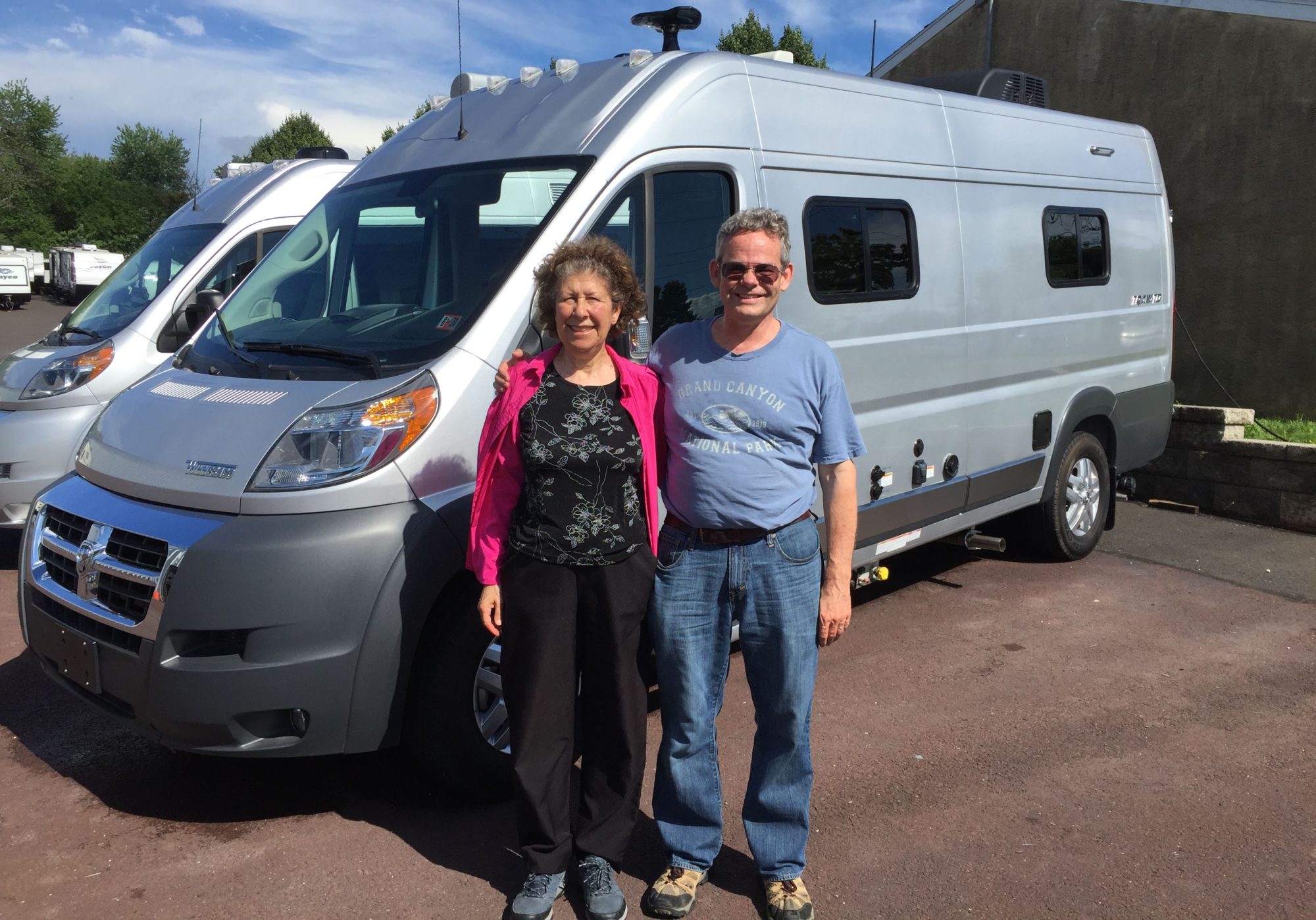Las Cruces (Nov. 14)
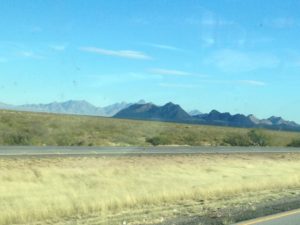 The route from Albuquerque to Las Cruces is mostly flat and dry, with spiky, dessicated mountains cropping up from time to time.
The route from Albuquerque to Las Cruces is mostly flat and dry, with spiky, dessicated mountains cropping up from time to time.
With our early start, we arrived at our La Hacienda Camping Resort in the early afternoon. The Resort has a pool and hot tub and a nice gift shop with local crafts, but is otherwise pretty much the usual RV parking lot.
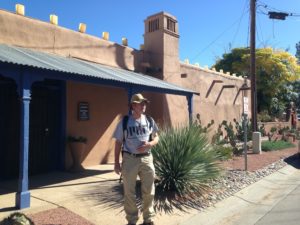
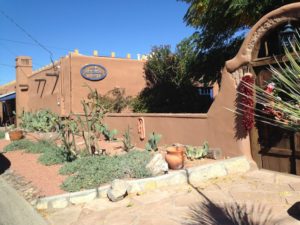
 On Wednesday we went into Mesilla, about a mile from the campground. Mesilla is the oldest part of Las Cruces, and consists of a large church and many older adobe buildings which are mainly now restaurants and tourist shops – some quite high end. It is very pretty and New Mexican. Mesilla was a stop on the historic Butterfield Stagecoach route from St. Louis to San Francisco. Like the Pony Express, this mail service ran for only a few years, but had a large impact in American western legend.
On Wednesday we went into Mesilla, about a mile from the campground. Mesilla is the oldest part of Las Cruces, and consists of a large church and many older adobe buildings which are mainly now restaurants and tourist shops – some quite high end. It is very pretty and New Mexican. Mesilla was a stop on the historic Butterfield Stagecoach route from St. Louis to San Francisco. Like the Pony Express, this mail service ran for only a few years, but had a large impact in American western legend.
Mesilla’s biggest claim to fame, however, is that Mesilla is the place where the famous outlaw, Billy the Kid, was convicted and incarcerated. Billy escaped from jail here, and was later killed in Fort Sumner, NM by his former friend, sheriff Pat Garrett – another piece of American legend.
We mostly just wandered around with Rumple, and dropped into a few shops. I confess I was sorely tempted to buy some clothes or souvenirs, but thoughts of all the stuff I already have prevailed. For lunch, we stopped at a restaurant with outdoor seating so that Rumple could stay with us.
The next day, we headed into Las Cruces to see the Zuhl Museum. This gem on the New Mexico State U. campus is a geology museum which specializes in petrified wood. We have never seen anything like it – both cross and longitudinal sections from around the world, as well as entire petrified logs.
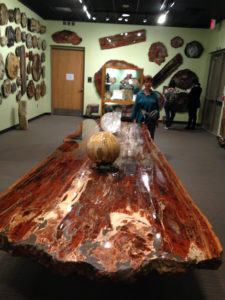
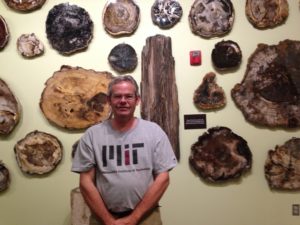
We really liked the petrified pine cones, as well. The museum also had a collection of large “crystal balls” like those on the table above, made from various minerals and a modest fossil collection.
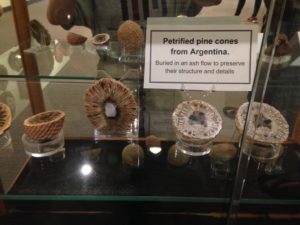
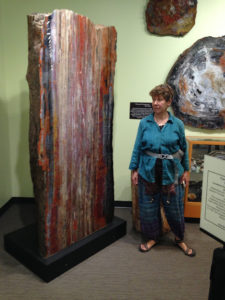
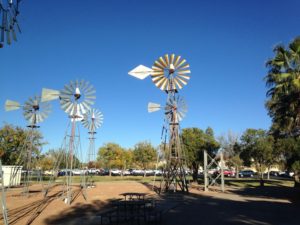 In the back yard of the Zuhl was an exhibit on windpowered water pumps, as seen to the right. In the northeast, these have been replaced by electric pumps; those that remain are ornamental wind vanes still turning but detached from the pumping mechanism. However, in the west, particularly on the cattle ranges, we saw plenty of pumps still working and filling reservoirs. This exhibit showed how the wind works the pistons that pumps the water.
In the back yard of the Zuhl was an exhibit on windpowered water pumps, as seen to the right. In the northeast, these have been replaced by electric pumps; those that remain are ornamental wind vanes still turning but detached from the pumping mechanism. However, in the west, particularly on the cattle ranges, we saw plenty of pumps still working and filling reservoirs. This exhibit showed how the wind works the pistons that pumps the water.
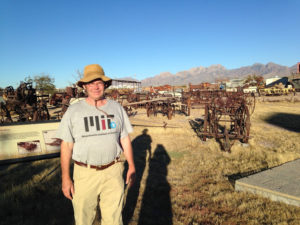
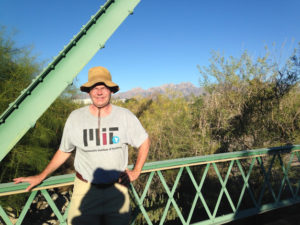 After the Zuhl, we continued out of town to the New Mexico Farm Museum. As promised, it had exhibits about farm life. We started by crossing the historic Green Bridge, moved to the museum from its former location on the Pecos River. This took us to the outdoor exhibits. We started in the Dairy Barn and learned about how milking was done historically and now, including the evolution of the milking machine. We saw a huge collection of old tractor parts. The museum boasts a large “zoo” of different breeds of beef and dairy cattle, including Texas longhorns (which are seldom seen on farms today). We also visited the saddlery, where the workshop of saddle maker Slim Green is on display along with some of the beautiful leather work he did. Unfortunately, we did not have time for the exhibits in the main building.
After the Zuhl, we continued out of town to the New Mexico Farm Museum. As promised, it had exhibits about farm life. We started by crossing the historic Green Bridge, moved to the museum from its former location on the Pecos River. This took us to the outdoor exhibits. We started in the Dairy Barn and learned about how milking was done historically and now, including the evolution of the milking machine. We saw a huge collection of old tractor parts. The museum boasts a large “zoo” of different breeds of beef and dairy cattle, including Texas longhorns (which are seldom seen on farms today). We also visited the saddlery, where the workshop of saddle maker Slim Green is on display along with some of the beautiful leather work he did. Unfortunately, we did not have time for the exhibits in the main building.
Both the Zuhl and the Farm Museum are part of the New Mexico State University. To get to the museums, we drove along the edge of campus. Although we did not stop to see the campus, we were struck at how similar the architecture was to the main quad of Stanford, with its red tile roofs and western style adobe-like architecture.
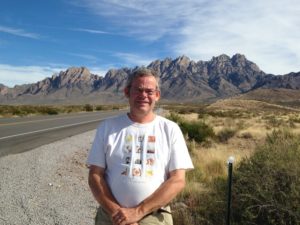 The scenery in Las Cruces is dominated by the Organ Mountains, a chunk of igneous extrusion (whatever that means). At the base of these mountains is an oasis, Dripping Springs, with a nice hike.
The scenery in Las Cruces is dominated by the Organ Mountains, a chunk of igneous extrusion (whatever that means). At the base of these mountains is an oasis, Dripping Springs, with a nice hike.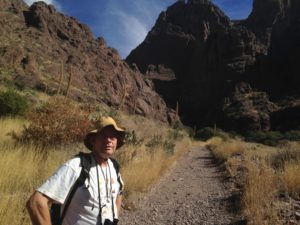 In the 1870s, a resort was built there and visitors came the 17 miles from Las Cruces by stage coach or horse to enjoy the setting. When the hotel was abandoned, a tuberculosis sanatorium was built on the site. Now the buildings are abandoned, but the stage coach road provide a good trail to the site, which is very pretty.
In the 1870s, a resort was built there and visitors came the 17 miles from Las Cruces by stage coach or horse to enjoy the setting. When the hotel was abandoned, a tuberculosis sanatorium was built on the site. Now the buildings are abandoned, but the stage coach road provide a good trail to the site, which is very pretty.
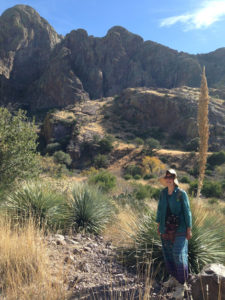 On Thursday, we headed out to Dripping Springs and walked along the old stage coach trail to the resort and sanatorium. The vegetation is interesting, with lots of varieties of yucca and other semi-arid plants. Due to the constant water supply from the springs, we expected wildlife. However, what we saw was an interesting assortment of insects.
On Thursday, we headed out to Dripping Springs and walked along the old stage coach trail to the resort and sanatorium. The vegetation is interesting, with lots of varieties of yucca and other semi-arid plants. Due to the constant water supply from the springs, we expected wildlife. However, what we saw was an interesting assortment of insects. 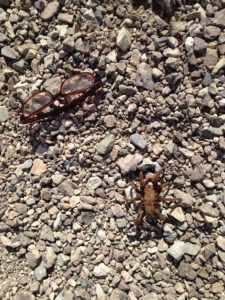 The most exciting, which we saw almost as soon as we started walking was a 4″ tarantula, (my glasses are in the picture for scale) walking calmly across the trail, as well as a smaller tarantula nearby. The grassy vegetation was full of grasshoppers, most of which were black while at rest but which had scarlet wings when they flew off. There were also a smaller number of grasshoppers which appeared similar while at rest but which had bright turquoise wings. Both varieties are very noisy in flight.
The most exciting, which we saw almost as soon as we started walking was a 4″ tarantula, (my glasses are in the picture for scale) walking calmly across the trail, as well as a smaller tarantula nearby. The grassy vegetation was full of grasshoppers, most of which were black while at rest but which had scarlet wings when they flew off. There were also a smaller number of grasshoppers which appeared similar while at rest but which had bright turquoise wings. Both varieties are very noisy in flight.
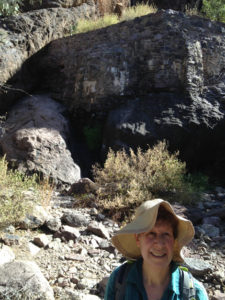 Near the springs and creek there are a lot of birds.
Near the springs and creek there are a lot of birds. 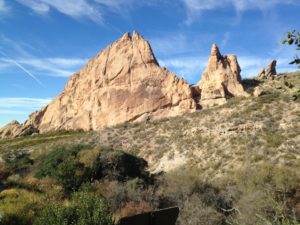
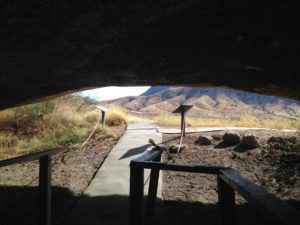 As well, from the spring you can hike around some interesting rock formations and also visit a cave that was inhabited for a while by a hermit. The cave is really an ideal dwelling – spacious and high enough to walk around in, with a nice view of the rock formations, valley and creek as can be seen from this photo taken from inside.
As well, from the spring you can hike around some interesting rock formations and also visit a cave that was inhabited for a while by a hermit. The cave is really an ideal dwelling – spacious and high enough to walk around in, with a nice view of the rock formations, valley and creek as can be seen from this photo taken from inside.
The hermit’s neighbors worried about him being alone and far from help. He agreed to light a fire outside the cave weekly so that they would know that he was OK. One week, there was no fire and he was found murdered.
The whole “wild west” meme was frequently brought to our attention, as historical plaques often noted that inhabitants of the historic building had been murdered.
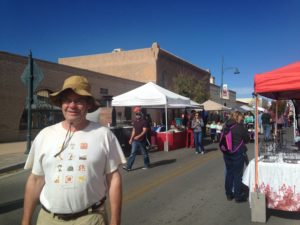
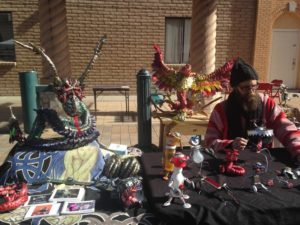 Saturdays and Wednesdays Las Cruces has a downtown Farmers’ Market. This would be more properly called a crafts market, as there were very few farm stalls. It also had the unique feature (at least on the Saturday when we were there) of having a children’s section, where many enterprising youngsters were selling crafts. (I bought a duck tape purse and a clay pendant – the latter because the 3 little girls staffing the booth were such excellent salesladies that I felt I had to buy something.)
Saturdays and Wednesdays Las Cruces has a downtown Farmers’ Market. This would be more properly called a crafts market, as there were very few farm stalls. It also had the unique feature (at least on the Saturday when we were there) of having a children’s section, where many enterprising youngsters were selling crafts. (I bought a duck tape purse and a clay pendant – the latter because the 3 little girls staffing the booth were such excellent salesladies that I felt I had to buy something.)
My favorite craft stall sold these amazing sculptures made of bottle caps.
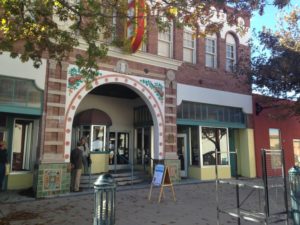 The vendors were very friendly. We spent quite a bit of time chatting with one woman whose main product was Jerusalem artichokes. I had previously been unsuccessful in getting much of a crop, so besides extolling the nutritional value of the tubers, she explained her experiences in cultivating them and concluded that I had not given them enough sunshine. We bought a few tubers, but I cannot say they will become a regular part of our diet.
The vendors were very friendly. We spent quite a bit of time chatting with one woman whose main product was Jerusalem artichokes. I had previously been unsuccessful in getting much of a crop, so besides extolling the nutritional value of the tubers, she explained her experiences in cultivating them and concluded that I had not given them enough sunshine. We bought a few tubers, but I cannot say they will become a regular part of our diet.
We also spent quite a long time chatting with a retired gentleman who made hand-knapped blades from both natural materials like flint and obsidian, and man-made materials like old TV screens. 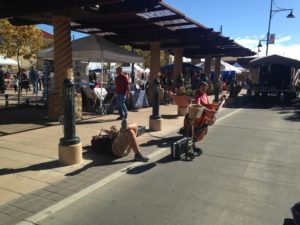 It was quite fascinating. He had some beautiful pieces, too. He uses modern cutting tools to make the blanks, which is less wasteful than flaking them by hand, and then finishing by hand knapping. He also had some very innovative handles.
It was quite fascinating. He had some beautiful pieces, too. He uses modern cutting tools to make the blanks, which is less wasteful than flaking them by hand, and then finishing by hand knapping. He also had some very innovative handles.
Of course, no farmers’ market is complete without some relaxing music. In this case, the musicians were also pretty relaxed – that is the horn player on his back on the sidewalk.
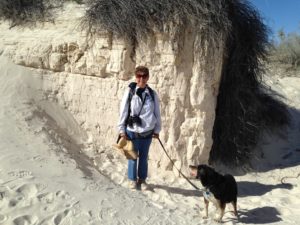 Our final day in the Las Cruces area was spent at White Sands National Park. This park, which is right beside the White Sands Missile Range, consists of huge dunes of white gypsum sand covering (according to Wikipedia) 442 square kilometers. I thought that the texture of the sand would be like drywall dust, but it is actually more like very fine table salt. The sand is formed from desert evaporites which are blown off the surface by the wind.
Our final day in the Las Cruces area was spent at White Sands National Park. This park, which is right beside the White Sands Missile Range, consists of huge dunes of white gypsum sand covering (according to Wikipedia) 442 square kilometers. I thought that the texture of the sand would be like drywall dust, but it is actually more like very fine table salt. The sand is formed from desert evaporites which are blown off the surface by the wind.
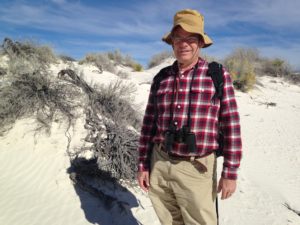 To reach the park, we drove through a pass in the mountains, which, in itself was quite interesting. We then drove through the missile range. We also had to pass through our first immigration checkpoint, which seems to be designed to make sure that vehicles are not transporting illegal immigrants. I was surprised at how quickly the big semis went through the checkpoint, but my nephew pointed out that there is probably heat-sensitive technology for scanning the rigs. We passed through several more of these in Arizona.
To reach the park, we drove through a pass in the mountains, which, in itself was quite interesting. We then drove through the missile range. We also had to pass through our first immigration checkpoint, which seems to be designed to make sure that vehicles are not transporting illegal immigrants. I was surprised at how quickly the big semis went through the checkpoint, but my nephew pointed out that there is probably heat-sensitive technology for scanning the rigs. We passed through several more of these in Arizona.
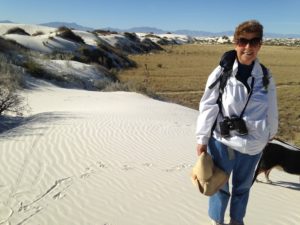 The dunes appear quite suddenly and seem to be confined to a certain region, perhaps a basin. Here I am at the edge.
The dunes appear quite suddenly and seem to be confined to a certain region, perhaps a basin. Here I am at the edge.
The drive through White Sands has many interpretative nature trail with notes about the flora and fauna. We enjoyed several of these. As well, visitors are allowed to toboggan down the dunes at various locations, and we enjoyed watching some of the tobogganners. 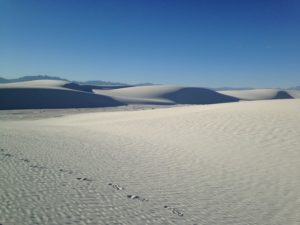 However, we did not get the full impact of the impact of the dunes until we got to the Alkali Flats Trail.
However, we did not get the full impact of the impact of the dunes until we got to the Alkali Flats Trail.
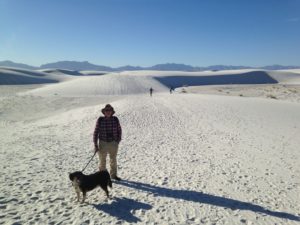 The Alkali Flats Trail is at the farthest point on the loop drive into the park and is not at all flat due to the dunes. It has no interpretative signs, and needs none. There is nothing but sand – huge white sand dunes. Except that the sand is so pure white, it looks like an idealized picture of what a sand desert should be. On our outward journey, we walked up the steep lee side of the dunes, and down the gentle windward side. This was very strenuous work in the loose sand.
The Alkali Flats Trail is at the farthest point on the loop drive into the park and is not at all flat due to the dunes. It has no interpretative signs, and needs none. There is nothing but sand – huge white sand dunes. Except that the sand is so pure white, it looks like an idealized picture of what a sand desert should be. On our outward journey, we walked up the steep lee side of the dunes, and down the gentle windward side. This was very strenuous work in the loose sand.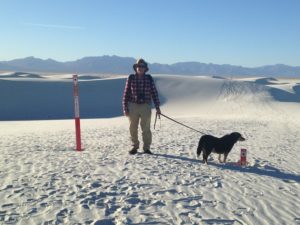 But on the return, we walked up the gentle slow side and then could literally leap down the steep slopes, landing in soft sand up to mid-calf. I had to empty my shoes several times. I really felt like a kid, launching myself down the slope like I was bouncing up and down on a bed.
But on the return, we walked up the gentle slow side and then could literally leap down the steep slopes, landing in soft sand up to mid-calf. I had to empty my shoes several times. I really felt like a kid, launching myself down the slope like I was bouncing up and down on a bed.
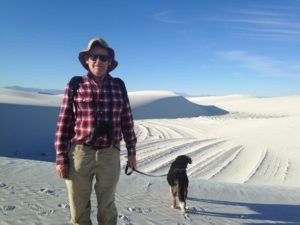 The force of the wind could be seen in many ways. The trail is marked with 6 foot steel markers – you can see here that these are often buried in sand after a few years. As well, in some places between the dunes there are flat areas that appear to have tire ruts. Upon closer examination, you can see that these are the compacted layers of sand from dunes that have been swept out of the area.
The force of the wind could be seen in many ways. The trail is marked with 6 foot steel markers – you can see here that these are often buried in sand after a few years. As well, in some places between the dunes there are flat areas that appear to have tire ruts. Upon closer examination, you can see that these are the compacted layers of sand from dunes that have been swept out of the area.
White Sands is really something very special and will have to do for me as the archetypal desert – at least until I make it to the Sahara.
White Sands
border patrol looking for illegals. Quick throughput for semis.
